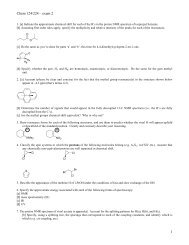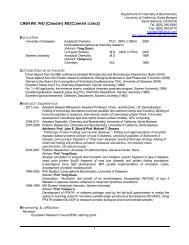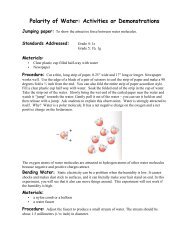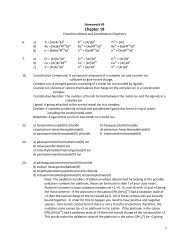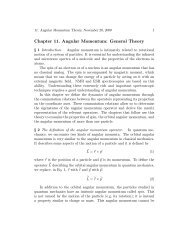Chapter 7. The Eigenvalue Problem
Chapter 7. The Eigenvalue Problem
Chapter 7. The Eigenvalue Problem
Create successful ePaper yourself
Turn your PDF publications into a flip-book with our unique Google optimized e-Paper software.
<strong>7.</strong> <strong>The</strong> <strong>Eigenvalue</strong> <strong>Problem</strong>, December 17, 2009 10<br />
N solutions. Because they are eigenvalues of A and A is Hermitian, these<br />
solutions mustallberealnumbers.<br />
I will assume here that you have heard of determinants. If not, take heart:<br />
computers can calculate them for you. Mathematica has the function Det[A]<br />
that returns the determinant of the matrix A.<br />
§ 8 Back to physics. IfAisanobservablethentheeigenvaluesofthe<br />
matrix A are the values that we observe when we measure the observable A.<br />
<strong>The</strong> “quantization” of the values that the observable can take occurs because<br />
(A − λI)ψ = 0 has solutions only for those special values of λ for which the<br />
matrix A − λI does not have an inverse. <strong>The</strong>se are the values of λ for which<br />
det[A − λI] = 0. Note that the spectrum of A depends only on the matrix<br />
A, as it should.<br />
If we use N functions in our orthonormal, complete basis set, the matrix<br />
A can have only N eigenvalues. <strong>The</strong> are not necessarily distinct, because<br />
some roots of the characteristic polynomial might be equal to each other. As<br />
we increase the number of functions in the orthonormal basis set, we increase<br />
the number of eigenvalues. If we use an infinite basis set, we will have an<br />
infinite number of eigenvalues. <strong>The</strong>se eigenvalues will be discrete, however.<br />
We cannot possible use an infinite basis set and therefore we never get<br />
the exact eigenvalues and eigenfunctions. By luck, or perhaps because of<br />
some mathematical theorem unknown to me, if we are intelligent in our<br />
choice of basis set, we get a good approximation to the smallest eigenvalues<br />
even with a relatively small basis set. As you’ll see in an example given later,<br />
using roughly 40 basis functions gives accurate values for about the 20 lowest<br />
eigenvalues.<br />
§ 9 An example of an eigenvalue problem: nondegenerate eigenvalues. Let<br />
us examine the eigenvalue problem for the matrix A given by Eq. 35. <strong>The</strong><br />
characteristic equation is (see Eq. 51)<br />
⎛<br />
⎜<br />
det ⎝<br />
3 − λ 2 4<br />
2 1.2 − λ 3.1<br />
4 3.1 4− λ<br />
⎞<br />
⎟<br />
⎠ =0 (52)<br />
If you find tedious algebra soothing, you can calculate this determinant.<br />
IprefertouseMathematica, and the result is (see Section 2 of the file<br />
WorkBook7 <strong>The</strong> eigenvalue problem.nb)<br />
−λ 3 +8.2λ 2 +9.21λ − 0.03 = 0 (53)




